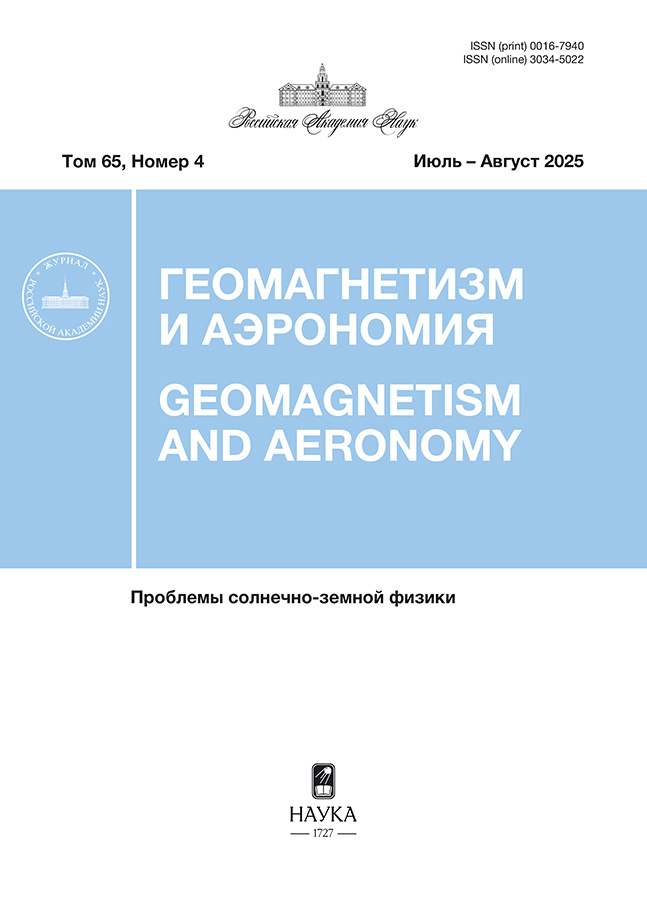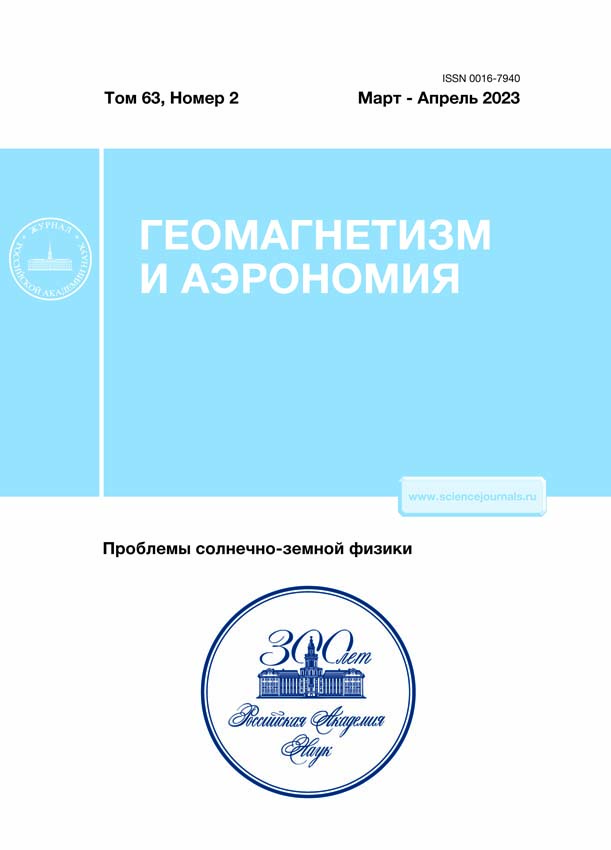Fine Structures of Type-IV Solar Radio Bursts Associated with Stationary and Moving Sources
- Authors: Fomichev V.V.1, Chernov G.P.1
-
Affiliations:
- Pushkov Institute of Terrestrial Magnetism, the Ionosphere, and Radio Wave Propagation (IZMIRAN), Russian Academy of Sciences
- Issue: Vol 63, No 2 (2023)
- Pages: 181-189
- Section: Articles
- URL: https://ruspoj.com/0016-7940/article/view/651025
- DOI: https://doi.org/10.31857/S0016794022600466
- EDN: https://elibrary.ru/DLPHJG
- ID: 651025
Cite item
Abstract
Various types of fine structure in the continuum emission of type-IV radio bursts are considered as
applied to different types of radiation sources, both stationary and moving. In the case of stationary sources,
the origin of the fine structure is associated both with processes in individual magnetic loops (quasi-periodic
acceleration and magnetohydrodynamic waves), and with large-scale processes associated with the propagation
of magnetohydrodynamic disturbances, the formation of loop arcades, and processes of discrete acceleration
of particles synchronous with them, causing the pulsating nature of radio emissions. For the case of a
moving source, the generation mechanism largely depends on the magnetic structure of the source (an
expanding magnetic arc or an isolated plasma cloud). In this case, the connection with coronal mass ejections
and shock waves is also important. Secondary pulsations are explained by a magnetohydrodynamic fluctuation
source in the form of a magnetic loop or cloud. The absence of other fine structures in the continuum of
moving type-IV bursts may be due to the critical angle of the loss cone for the excitation of whistlers
About the authors
V. V. Fomichev
Pushkov Institute of Terrestrial Magnetism, the Ionosphere, and Radio Wave Propagation (IZMIRAN), Russian Academy of Sciences
Email: gchernov@izmiran.ru
Moscow, Troitsk, 108840 Russia
G. P. Chernov
Pushkov Institute of Terrestrial Magnetism, the Ionosphere, and Radio Wave Propagation (IZMIRAN), Russian Academy of Sciences
Author for correspondence.
Email: fomichev@izmiran.ru
Moscow, Troitsk, 108840 Russia
References
- ‒ Железняков В.В., Злотник Е.Я., Зайцев В.В., Шапошников В.Е. Эффект двойного плазменного резонанса и его роль в радиоастрономии // УФН. Т. 186. С. 1090‒ 1116. 2016. https://doi.org/10.3367/UFNe.2016.05.037813
- ‒ Зайцев В.В., Степанов А.В. О природе пульсаций солнечного радиоизлучения IV типа // Исслед. по геомагнетизму, аэрономии и физике Солнца. Вып. 37. С. 11‒ 18. 1975.
- ‒ Aschwanden M.J., Alexander D. Flare plasma cooling from 3 MK down to 1 MK modeled from Yohkoh, GOES, and TRACE observations during the Bastille Day Event (14 July 2000) // Sol. Phys. V. 204. P. 91‒120. 2001.
- ‒ Boischot A. Caracteres d’un type d’emission hertzienne associe a certaines Eruptions chromospheriques // Comptes Rendus, Acad. Sci. Paris. V. 244. P. 1326‒1329. 1957.
- ‒ Caroubalos C., Alissandrakis C.E., Hillaris A. et al. ARTEMIS IV radio observations of the 14 July 2000 large solar event // Sol. Phys. V. 204. P. 167‒179. 2001.
- ‒ Chernov G.P. Fine structure of solar radio bursts. Heidelberg: Springer, 282 p. 2011.
- ‒ Chernov G.P., Kaiser M.L., Bougeret J.-L., Fomichev V.V., Gorgutsa R.V. Fine structure of solar radio bursts observed at decametric and hectometric waves // Sol. Phys. V. 242. P. 145‒169. 2007a. https://doi.org/10.1007/s11207-007-0258-y
- ‒ Chernov G.P., Stanislavsky A.A., Konovalenko A.A. et al. Fine structure of decametric type II radio bursts // Astronomy Letters. V. 33. P.192‒202. 2007b. https://doi.org/10.1134/S1063773707030061
- ‒ Chernov G.P. Unusual stripes in emission and absorption in solar radio bursts: Ropes of fibers in the meter wave band // Astron. Lett. V. 34. P. 486–499. 2008. https://doi.org/10.1134/S1063773708070074
- ‒ Chertok I.M., Fomichev V.V., Gnezdilov A.A. et al .Multi-scale temporal features of the 14 July 2000 meterwavelength dynamic radio spectrum compared with TRACE data // Sol. Phys. V. 204. C. 141‒254. 2001.
- ‒ Elgarøy Ø. Observations of the fine structure of Enhanced solar radio radiation with a narrow-band spectrum analyser // Nature. V. 184. P. 887‒888. 1959. https://doi.org/10.1038/184887a0
- ‒ Iskov V.N., Chertok I.M., Chernov G.P., Fomichev V.V. et al. Analysis of the flare of May 16, 1981 with a complex space-time structure using optical, X-ray and radio observations // Bull. Astr. Inst. Czechoslovakia. V. 36. P. 81‒97. 1985.
- ‒ Gary D.E., Dulk G.A., House L.L. et al. The Type IV burst of 1980 June 29, 0233 UT: Harmonic plasma emission? // Astron. Astrophys. V. 52. P. 42‒50. 1985.
- ‒ Gopalswami N. History and development of coronalmass ejections as a key player in solar terrestrial relationship // Geosci. Lett. V. 3. № 8. P. 1‒18. 2016. https://doi.org/10.1186/s40562-016-0039-2
- ‒ Mann G., Baumgartel K., Chernov G.P., Karlicky M. Interpretation of a special fine structure in type IV solar radio bursts // Sol. Phys. V. 120. P. 383‒391. 1989.
- ‒ Masuda S., Kosugi T., Hudson H.S. // Sol. Phys. V. 204. P. 55‒67. 2001. https://doi.org/10.1023/A:1014230629731
- ‒ Morosan D.E., Kilpua E.K.J., Carley E.P., Monstein C. Variable emission mechanism of a Type IV radio burst // Astron. Astrophys. V. 623. № A63. P. 1‒12. 2019. https://doi.org/10.1051/0004-6361/201834510
- ‒ Morosam P.E., Kumari A., Kilpua E.K.J., Hamini A. Mo-ving solar radio bursts and their association with coronal mass ejections // Astron. Astrophys. V. 647. № L12. P. 1‒5. 2021. https://doi.org/10.1051/0004-6361/202140392
- ‒ Pick M., Forbes T.G., Mann G. et al. Multi-wavelength observations of CMEs and associated phenomena / Report of Working Group F. // Space Sci. Rev. V. 123. P. 341‒382. 2006. https://doi.org/10.1007/s11214-006-9021-1
- ‒ Pick M., Vilmer N. Sixty-five years of solar radioastronomy: flares, coronal mass ejections and Sun–Earth connection // Astron. Astrophys. Rev. V. 16. P. 1–153. 2008. https://doi.org/10.1007/s00159-008-0013-x
- ‒ Ramesh R., Kishore P., Mulay Sargam M. et al. Low-frequency observations of drifting, non-thermal continuum radio emission associated with the solar coronal mass ejections // The Astrophys. J. V. 778:30. P. 1–8. 2013. https://doi.org/10.1088/0004-637X/778/1/30
- ‒ Reiner M.J., Kaiser M.L., Karlicky M. et al. Bastille day event: a radio perspective // Sol. Phys. V. 204. P. 123‒139. 2001.
- ‒ Riddle A.C. 80 MHz observations of a moving type IV solar burst, March 1, 1969 // Sol. Phys. V. 13. P. 448‒457. 1970.
- ‒ Robinson R.D. The relation between flare-related metric continuum bursts and coronal mass ejections // Sol. Phys. V. 104. P. 33‒39. 1986.
- ‒ Rosenberg H. Evidence for mhd pulsations in the solar corona // Astron. Astrophys. V. 9. P. 159‒162. 1970.
- ‒ Trottet G., Kerdraon A., Benz A.O., Treumann R.A. Quasi-periodic short-term modulations during a moving type IV burst // Astron. Astrophys. V. 93. P. 129‒135. 1981.
- ‒ Vršnak B., Warmuth A., Temmer M. et al. Multi-wavelength study of coronal waves associated with the CME-flare event of 3 November 2003 // Astron. Astrophys. V. 448. P. 739‒752. 2006. https://doi.org/10.1051/0004-6361:20053740
- ‒ Wang S.J., Yan Y.H., Zhao R.Z., Fu Q.J. et al. Broadband radio bursts and the structures during the great solar event on 14 July 2000 // Sol. Phys. V. 204. P. 155‒166. 2001.
- ‒ Wild J.P. The radioherliograph and the radio astronomy programme of the Culgoora Observatory // Proc. Astron. Soc. Australia. V. 1. P. 28‒30. 1967.
- ‒ Zaitsev V.V., Stepanov A.B., Chernov G.P. Pulsations of the type IV radio bursts as an indicator of protonability of solar flare // Sol. Phys. V. 93. P. 363‒377. 1984.
- ‒ Zheleznyakov V.V., Zlotnik E.Ya. Cyclotron wave instability in the corona and origin of solar radio emission with fine structure. III. Origin of zebra pattern // Sol. Phys. V. 44. P. 461‒470. 1975.
Supplementary files

















